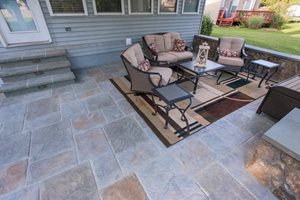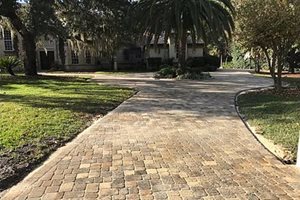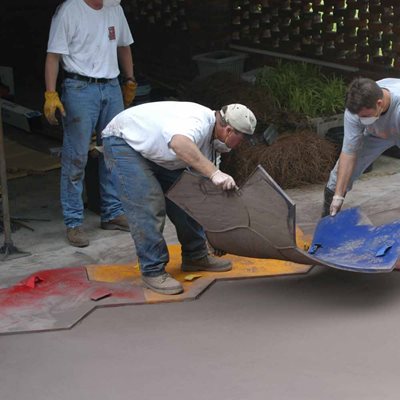
Texian Concrete in Houston, TX.
How do the decorative options differ?
Concrete pavers are great for recreating the look of natural stone or brick. They come in a wide array of colors, stone-like shapes, and sizes, and you can mix and match paver patterns and colors to create striking borders and color contrasts (see our concrete paver photo gallery).
Stamped concrete also allows you to create pavements that resemble natural stone or brick, but unlike pavers, random stone and wood patterns are possible as well (see the most popular stamping patterns for concrete patios and driveways). Stamped concrete also gives you the ability to impart seamless stone-like textures — without pattern or grout lines — through the use of texture skins. Another advantage of stamped concrete is the ability to customize the color. Through the use of concrete stains or dry-shake color hardeners, stamped concrete can be made to look identical to real stone and antiqued to create realistic weathering effects.
How to choose: Both stamped concrete and concrete pavers give you endless design flexibility. The choice often depends on the look you want to achieve. If customization of color is a priority, stamped concrete will better suit your needs.
Is maintenance different for stamped concrete vs. pavers?
Both stamped concrete and concrete pavers require routine cleaning and maintenance to keep them looking their best and to protect them from wear and tear. Both can also benefit from the application of a sealer every few years to enhance the color and minimize surface abrasion. But with concrete pavers, additional maintenance is often required to keep the joints between paving units filled with sand.
Depending on weather exposure, you may need to replenish the sand in the joints every 2 or 3 years to prevent weed growth. The paving units can also shift or settle over time, requiring releveling or replacement. You can minimize joint maintenance by filling the joints with a polymer sand, which contains a special polymeric additive that binds and hardens the sand and helps to prevent erosion.
How to choose: For both types of paving materials, applying a sealer will make cleaning easier by preventing the penetration of oil and stains. (See this guide to maintaining and caring for exterior decorative concrete.) However, if you don't want to bother with the extra step of resanding the joints periodically, choose poured-in-place concrete.




